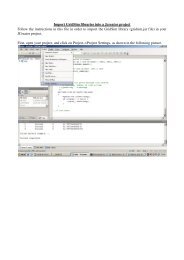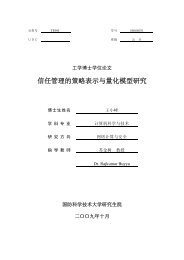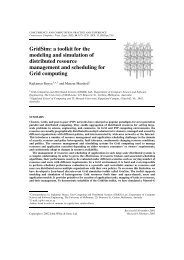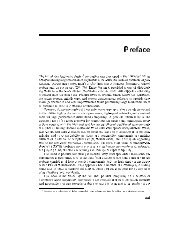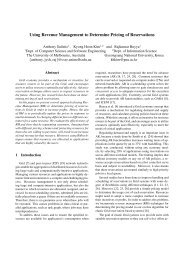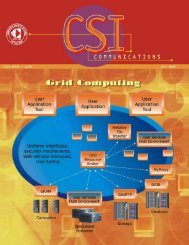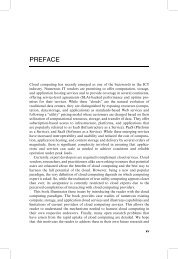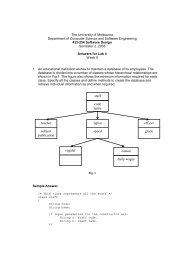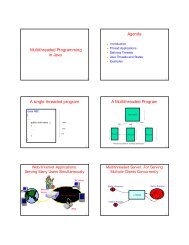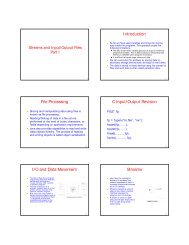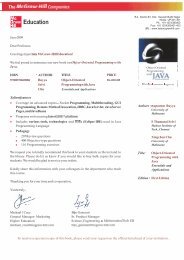Platforms For Building And Deploying ... - Rajkumar Buyya
Platforms For Building And Deploying ... - Rajkumar Buyya
Platforms For Building And Deploying ... - Rajkumar Buyya
- No tags were found...
Create successful ePaper yourself
Turn your PDF publications into a flip-book with our unique Google optimized e-Paper software.
Cover Story<strong>Rajkumar</strong> <strong>Buyya</strong> 1,2 and Karthik Sukumar 21Cloud Computing and Distributed Systems (CLOUDS) Laboratory, Dept. of Computer Science and Software Engineering.The University of Melbourne, Parkville, VIC 3010, Australia2Manjrasoft Pvt. Ltd., ICT <strong>Building</strong>, 111, Barry Street, Carlton, Melbourne, VIC 3053, Australia. {karthik, raj}@manjrasoft.com<strong>Platforms</strong> for <strong>Building</strong> and <strong>Deploying</strong>Applications for Cloud ComputingCloud computing is rapidly emerging as a new paradigm fordelivering IT services as utlity-oriented services on subscriptionbasis.The rapid development of applications and their deploymentin Cloud computing environments in efficient manner is a complextask. In this article, we give a brief introduction to Cloud computingtechnology and Platform as a Service, we examine the offerings inthis category, and provide the basis for helping readers to understandbasic application platform opportunities in Cloud by technology’ssuch as Microsoft Azure, Sales <strong>For</strong>ce, Google App, and Anekafor Cloud computing. We demonstrate that Manjrasoft Aneka isa Cloud Application Platform (CAP) leveraging these conceptsand allowing an easy development of Cloud ready applicationson a Private/Public/Hybrid Cloud. “Aneka CAP” offers facilitiesfor quickly developing Cloud applications and a modular platformwhere additional services can be easily integrated to extend thesystem capabilities, thus being at pace with the rapidly evolution ofCloud computing.ClientsCloudManagerPrivateCloudFig. 1 : A bird’s eye view of Cloud computing.OtherCloud ServicesPublic CloudGovt.Cloud Services<strong>Rajkumar</strong> <strong>Buyya</strong>Karthik Sukumar1. IntroductionCloud computing is rapidly emergingas a new paradigm for deliveringcomputing as a utility [1]. It allowsleasing of IT capabilities whether theyare infrastructure, platform, or softwareapplications as services on subscriptionorientedservices in a pay-as-you-gomodel. Its foundation is based on variousdevelopments in IT during the last thirty toforty years. As fresh ideas and technologyadvancement have made it all the morestriking and appealing during the Internetage, the way consumers consume andtechnology enablers deliver solutionshas evolved. With a trend towards Cloudbased model, the power is shifted toconsumers. They have access to morecompute power and to new applications,at an alluring price, as well as they enjoythe advantages of a self-service and selfmanagedenvironment.Cloud computing fosters elasticityand seamless scalability of IT resourcesthat are offered to end users as aservice through Internet medium. Cloudcomputing can help enterprises improvethe creation and delivery of IT solutionsby providing them to access services in amost cost effective and flexible manner.A bird’s eye view of Cloud computing isshown in Figure 1.Although Cloud computing hasemerged mainly from the appearanceof public computing utilities [2], variousdeployment models, with variations inphysical location and distribution, haveCSI Communications | May 2011 | 6www.csi-india.org
een adopted. In this sense, regardless ofits service class, Clouds can be classifiedas public, private, or hybrid depending onthe model of deployment. A public Cloud isa Cloud made available in a pay-as-yougomanner to the general public. A privateCloud is a data center of an organization,not made available to the general public.A hybrid Cloud is a seamless use ofpublic Cloud along with private Cloudwhen needed. In a typical public Cloudscenario, a third-party vendor deliversservices such as computation, storage,networks, virtualization and applicationsto various customers. In a private Cloudenvironment, internal IT resources areused to serve their internal users andcustomers. Businesses are adopting publicCloud services to save capital expenditureand operational cost by leveraging Cloud’selastic scalability and market orientedcosting features. Nevertheless, publicCloud computing also raises concernsabout data security, management, datatransfer, performance, and level of control.Cloud Computing started with a riskfreeconcept: let someone else take theownership of setting up IT infrastructureand let end-users tap into it, paying onlyfor what is been used. From this simpleidea, a much more sophisticated, complex(and sometimes complicated) marketstarted to grow. Today, businesses canbuy computation resources, infrastructureplus platform or infrastructure plusapplications. In the language of thismarket, the computation resources isfrequently referred to as Infrastructureas a Service (IaaS), and the applicationsas Software as a Service (SaaS). In fact,use of the acronym appears ubiquitouslyfrom SaaS to PaaS (Platform as a Service)to XaaS (Anything as a Service). Keycharacteristics and vendors offering theseCloud services are highlighted in Fig.2.What makes Cloud computingdifferent from traditional IT approachesis the focus on service delivery andthe consumer utilization model. Inthe background, service provider’suses particular technologies, systemarchitecture, design and industry bestpractices to provide and support thedelivery of service-oriented, elasticallyscalable environment serving multiplecustomers. This helps end users to havemore agile and flexible service orientedarchitecture for their application andCategory Characteristics Cloud ProvidersSoftware as a Service (SaaS)Software as a service (SaaS) refers toapplications delivered as cloud services wherecustomers are provided with applications thatare accessible anytime and from anywhere.Platform as a Service (PaaS)Platform-as-a-Service (PaaS) refers toenvironment for application developmentwith seamless Integration with Cloud forapplication hostingInfrastructure as a Service (IaaS)Infrastructure-as-a-Service (IaaS) refersto on-demand computing capacity from aservice provider which is virtualized hardwareand storageFig. 2 : Cloud service types, characteristics, and vendors.services. In a conventional IT scenario,most software companies have procureddifferent components of their applicationmiddleware infrastructure layer fromvarious vendors, and brought togetherthese tools into a corporate environmentusing system integration services andtools. On the other hand, in a Cloudcomputing scenario, this practice is quiterare. Platform-as-a-Service solutionsprovide environment and applicationsdevelopment platforms for seamlesslyintegrating Cloud computing into existingapplication, services, and infrastructurewith a market-oriented approach.2. Cloud Application Development<strong>Platforms</strong>Applicationdevelopment,deployment and runtime managementhave always been reliant on developmentplatforms such as Microsoft’s .NET,WebSphere, or JBoss, which have beendeployed on-premise traditionally. In theCloud-computing context, applicationsare generally deployed by Cloud providersto provide highly scalable and elasticservices to as many end users as possible.The need for support as many users toaccess and utilize the same applicationservices, with elastic resources allocationhave led to enhancement in developmentplatform technologies and architecturesto handle performance, security, resourceallocation, application monitoring, billing,and fault tolerance.There are several solutions availableApplications on SaaSApplication Dev PlatformAutomation ProvisioningManagement PackageInfrastructure ServiceVirtualizationNetwork /Processing / Storage• Google Apps• Zoho Office• Salesforce.com• Microsoft OfficeLive• <strong>For</strong>ce.com• Google App Engine• Microsoft Azure• Boomi• Manjrasoft Aneka• Amazon EC2• Go Grid• Rack Space• Sun Grid• VM Ware• Zen Serverin the PaaS market, to mention a few:Google App Engine, Microsoft WindowsAzure, <strong>For</strong>ce.Com, and ManjrasoftAneka. Google App Engine provides anextensible runtime environment for webbased applications developed with Javaor Python, which leverage huge Google ITinfrastructure. Windows Azure providesa wide array of Windows based servicesfor developing and deploying windowsbased applications on the Cloud. It makesuse of the infrastructure provided byMicrosoft to host these services and scalethem seamlessly. Aneka provides a moreflexible model for developing distributedapplications and provides integration withexternal Clouds such as Amazon EC2 andGoGrid. Aneka offers the possibility toselect the most appropriate infrastructuredeployment without being tied to anyspecific vendor–a virtual infrastructure,a private datacenter or a server –thusallowing enterprises to comfortably scaleto the Cloud when needed.2.1 Windows AzureThe Windows Azure Platform [3]consists of SQL Azure and the .NETservices. The .NET services comprises ofAccess Control services and .NET servicebus. Windows Azure is a platform withshared multitenant hardware provided byMicrosoft. Windows Azure applicationdevelopment mandates the use ofSQL Azure for RDBMS functionality,because that is the only coexisting DBMSfunctionality accessible in the sameCSI Communications | May 2011 | 7
hardware context as the applications.2.2 Google App EngineGoogle App Engine is offeredby Google Inc. Its key value is thatdevelopers can rapidly build small webbased applications on their machine anddeploy them on the Cloud. A notablething is that Google App Engine providesdevelopers with a simulated environmentto build and test applications locally withany operating system or any system thatruns a suitable version of Python and Javalanguage environments. Google uses theJava Virtual Machine with Jetty Servletengine and Java Data Objects.2.3 <strong>For</strong>ce.com<strong>For</strong>ce.com is a developmentand execution environment that isindependent for Salesforce.com. <strong>For</strong>ce.com is the best approach for Platformas-a-Service(PaaS) for developing CRMbased application and, with regardsto the design of its platform and theruntime environment is based on theJava technology. The platform uses aproprietary programming language andenvironment called Apex code, which ithas a reputation for simplicity in learningand rapid development and execution.2.4 Manjrasoft AnekaAneka [4] is a distributedapplication platform for developing Cloudapplications. Distributed means thatAneka can seam together any numberof Windows based physical or virtualdesktops or servers into a network ofinterconnected nodes that act as a singlelogical “application execution layer.” Themiddleware is managed and monitoredwith advanced tools that allow monitoringapplications’ performance and the systemstatus in order to meet the Service LevelAgreements (SLAs) made with the users.Aneka-based Clouds can be deployed on avariety of hardware and operating systemsincluding several flavors of the Windowsand Linux operating system families.This flexibility allows Aneka to virtuallyharness almost all the different types ofinfrastructure and runtime environmentto serve application execution on demand.3. Aneka Cloud ApplicationPlatformAneka [4] is a platform fordeveloping resource-intensive and elasticapplications and their deployment onClouds. It can harness a huge variety ofphysical and virtual resources, rangingfrom desktops, clusters, to virtualdatacenters, to provide a single logical“application execution layer”. The keycomponents of the platform are depictedin Figure 3, which gives an overall viewof Aneka from its foundations to theapplications and the end user services.The platform is based on an extensibleService Oriented Architecture (SOA),which makes the integration of newcomponents, incremental developmentof new features, and infrastructuredeployment and configuration seamlesstasks.Middleware. The platform featuresa homogeneous distributed runtimeenvironment for applications. Suchenvironment is built by aggregatingtogether physical and virtual nodeshosting the Aneka container. The containeris lightweight layer that interfaces withthe hosting environment and managesthe services deployed on a node. Servicesconstitute the core logic of Aneka Cloudsand each container hosts three differentclasses of services:• Fabric Services. Fabric servicesimplement the fundamental operationsof the infrastructure of the Cloud. Theseservices include: high-availability andfailover for improved reliability, nodemembership and directory, resourceprovisioning, performance monitoring andhardware profiling.• Foundation Services. Foundationservices constitute the core functionalitiesof the Aneka middleware. They providea basic set of capabilities that enhanceapplication execution in the Cloud. Theseservices provide the infrastructure withadded value and are both of use forsystem administrators and developers.Within this category we can list: storagemanagement, resource reservation,reporting, accounting, billing, servicesmonitoring, and licensing. Services inthis level operate across all the range ofsupported application models.• Application Programming Services.Application services deal directly withthe execution of applications and arein charge of providing the appropriateruntime environment for each applicationmodel. At this level Aneka expressesits true potential in supporting differentapplication models and distributedprogramming patterns. Aneka providessupport for the most known applicationprogramming patterns such as distributedthreads, bag of tasks, and MapReduce.Application Development andManagement. Aneka offers advancedfeatures for developing and managingapplications on the Cloud. The SoftwareDevelopment Kit (SDK) and theManagement Kit are the two componentsexposing such capabilities. They providemeans for interacting with the middlewareand managing it with advanced userinterfaces and bindings for applications.By using Aneka SDK, developers canquickly develop distributed applications,integrate the scaling capabilities ofAneka into existing applications, orimplement new services to extend thepotential of Aneka. The ManagementKit allows deploying, managing, andtuning Aneka-based Clouds. By usinga visual approach, it provides means toaccess and control every aspect of themiddleware and also offers advancedfeatures such as application reporting,accounting, billing, user management, andperformance monitoring. The SDK and theManagement Kit are the tools that enrichthe user experience of developers andadministrators respectively.4. Cloud Application ProgrammingModels and their Support in AnekaAneka Clouds aim to be a ubiquitousenvironment serving any type of computingneed of distributed applications.Therefore, they are expected to be flexibleenough to support several differentmodels for developing applications:parameter sweep, concurrent, and dataintensiveapplications. In order to servethis purpose, Aneka provides engineersand developers with the concept of“Programming Model”, which is collectionof abstractions and runtime support forexpressing and developing distributedapplications. The platform currentlysupports three different programmingmodels. They are: Task, Thread, andMapReduce [5]. Moreover, its extensiblearchitecture offers the freedom toplug other models into the existinginfrastructure. By taking this approachAneka is able to provide support for all thefollowing types of distributed applications:Parameter Sweep Applications:Task Programming. Task Programmingprovides developers with the ability ofCSI Communications | May 2011 | 8www.csi-india.org
ApplicationSoftware Development KitAPIsContainerProgramming ModelsTask ModelFoundation ServicesMembershipServicesFabric ServicesInfrastructureFig. 3 : Aneka platform architecture.expressing applications as a collectionof independent tasks. Each task canperform a different operation, or thesame operation on different data, and canbe executed in any order by the runtimeenvironment. Task programming allowsthe parallelization of legacy applicationson the Cloud. Application from variousdomains including scientific computing,financial applications, media renderingand transcoding can be created usingTask programming model. This modelis the most popular in distributedcomputing and can be used as a startingpoint for implementing new modelssuch as workflows with more complexrequirements.Concurrent Applications: ThreadProgramming. The main abstraction ofthis model is the concept of thread whichmimics the semantic of the commonlocal thread but is executed remotely inManagement KitManagementStudioDynamic Resource Provisioning Services.NET @ WindowsDesignExplorerThread ModelReservationServicesPrivate CloudLAN networkStorageServicesSLA-NegotiationWeb ServicesMap ReduceModelHardware Profile ServicesLicenseServicesPhysical Machines/Virtual MachinesMicrosoftMono @ LinuxAdministrationPortalManagementWeb ServicesOtherModelAccountingServicesMicrosoftIBMData CenterGooglePersistenceSecuritya distributed environment. This modeloffers major control on the execution of thesingle components of an application butrequires more management if comparedwith Task Programming, which is basedon a “submit and forget” pattern. Thismodel covers all the application scenariosof the Task programming and solvesthe additional challenges of providing adistributed runtime environment for localmulti-threaded applications.Data Intensive Applications:MapReduce. This model is animplementation of the MapReduce model,as proposed by Google, for .NET andintegrated with Aneka. MapReduce hasbeen designed to process a huge quantityof data by using simple operations thatextracts useful information from a dataset(the map function) and aggregatesthis information together (the reducefunction). MapReduce can be a winningsolution for data mining and analyticapplications, bulk media processing, andcontent indexing. Aneka provides a solidsupport for the model and integrates itwith all the other foundation services suchas accounting and reporting, thus makingthis solution a competitive alternativewithin the same market segment.5. High-Performance CloudApplicationsAneka has been used in creatingseveral interesting applications in domainssuch as life sciences, engineering, andcreative media. Applications createdusing Aneka are able to run on enterpriseor public Clouds without any change. Thethree case studies on the use of Anekafor building applications in engineering,geospatial, and life science domains arediscussed below.5.1 Manufacturing and EngineeringThe Manufacturing and Engineeringsectors include a wide range of marketsegments, from aerospace to automotive.Manufacturing organizations face anumber of computing challenges as theyseek to optimize their IT environments,including high infrastructure costs andcomplexity to poor visibility into capacityand utilization. Today’s design engineersneed access to unrestrained, flexiblecomputing capacity on demand, so thatdesign cycles can be as fast, cheap, andproductive.The GoFront group, a division ofChina Southern Railway, is responsiblefor designing the high speed electriclocomotive, metro car, urbantransportation vehicle and the motortrain. The raw design of the prototypesrequires high quality 3D images usingAutodesk’s rendering software calledMaya. By examining the 3D images,engineers identify problems in the originaldesign and make the appropriate designimprovements. However, such designs ona single four core served used to 3 days torender scenes with 2000 frames.To reduce this time, GoFront has usedAneka and created an enterprise Cloud(see Figure 4) within their company byutilizing networked PCs. They used AnekaDesign Explorer, a tool for rapid creationof parameter sweep applications, in whichthe same program is executed manytimes on different data items (in this case,executing the Maya software for renderingdifferent images). A customized DesignCSI Communications | May 2011 | 9
Explorer (called Maya GUI) has beenimplemented for Maya rendering. MayaGUI managed parameters, generatedAneka tasks, monitored submitted Anekatasks and collected completed renderedimages. The design image used to takethree days to render (2000+ frames,each frame with more than five differentcamera angles). Using only a 20 nodeAneka Cloud, GoFront was able to reducethe rendering scenario from 3 days to 3hours.5.2 Geospatial Sciences andTechnologiesDue to the continuous growth of GISsciences and technologies, there havebeen even more geospatial and nonspatialdata involved due to increase innumber of data sources and advancementof data collection methodologies. Spatialanalysis and Geo-computation aregetting intricate and computationallydemanding. The Department of Space,Government of India, adopted Aneka asthe Cloud computing platform supportingthe development of high performanceGIS applications [6]. Aneka enablesa new approach to complex analysesof massive data and computationallyintensive environments, and gives theopportunity to satisfy all the requirementsof a high-performance and distributed GISenvironment over the public, private andhybrid Clouds.5.3 Health and Life ScienceWith the high volume and density ofdata, along with the growing complexityof IT ecosystem and the pressures ofcompetition and regulatory groups,life sciences organizations need ITinfrastructure and management tools thatcan respond quickly to changing needsand, more importantly, enable rather thanhamper the ability to innovate.Aneka enables faster execution andmassive data computation in life scienceR&D, clinical simulation, and businessintelligence tools. It helps organizationsto achieve greater levels of innovationin shorter timeframes while maximizinglicense utilization, increasing ROI, andrealizing significant savings over Cloudbased technology. <strong>For</strong> its application inreal time scenario, Jeeva, an EnterpriseCloud enabled portal for protein secondarystructure prediction, was developedbased on Aneka. Research scientists usethe portal to discover new predictionstructures using parallel executionmethods. The prediction took 20 minutesto complete when compared with theprevious computational time of 8 hours.Also, Aneka has enabled implementationof personal health monitoring systemaiding rehabilitation of stroke patients onpublic Cloud platform such as AmazonEC2.5.4 IT Education and ResearchAs the IT field is rapidly movingtowards Cloud Computing, softwareindustry’s focus is shifting fromdeveloping applications for PCs toData Centers and Clouds that enablemillions of users to make use of softwaresimultaneously. This is creating a hugedemand for manpower with skills inthis area. Educational and researchorganizations require a platform that cansupport (1) multiple models of applicationprogramming, (2) multiple types of Clouddeployments (private, public, or hybrid),and (3) extensible framework enablingeducators/researchers to develop theirown programming models and applicationschedulers.Since Aneka allows one to build aprivate Cloud with minimal investmentAneka Maya RendererGoFront Private AnekaCloudUse privateAneka CloudLAN network(Running Maya Batch Mode on demand)Setup 2: AnekaEnterprise CloudTime(in hrs)805075506000 FramesRaw Locomotive Design Files(Using AutoDesk Maya)Setup 1: Single ServerUsing MayaGraphical ModeDirectly4020025SingleServer10 83.3AnekaCloud4000 Frames2000 Frames4 croresserverAneka utilizes idle desktops(30) to decrease task timefrom days to hoursFig. 4 : Rending images of locomotive design on GoFront’s private Cloud using Aneka.CSI Communications | May 2011 | 10www.csi-india.org
y harnessing their existing IT resources(e.g., LAN-connected PCs), it has emergedas an excellent platform for teachingand research in Cloud computing area.A number of institutions in India such asMSRIT-Bangalore and C-DAC (Center forDevelopment of Advanced Computing),Hyderabad, and other countries have usedAneka for setting up a Cloud ComputingLab and used it to offer practical exposureto their students (studying Cloud/Grid/High-Performance computing courses)in addition to building applications.Researchers in National Institute ofTechnology (NIT-Karnataka) have usedAneka for developing and evaluatingnew QoS-based resource provisioningand application scheduling algorithms.<strong>For</strong> case studies and to download Anekaplatform, please visit http://www.manjrasoft.com/6. Conclusions and FutureDirectionsThe growing interest in Cloudcomputing has led to new approachesfor allocating financial resources andleveraging IT infrastructure and services.Cloud computing provides concreteopportunity for making a flexible useof IT by turning it into a utility. Cloudadoption is becoming a standard practicein many business sectors to scale ITinfrastructure on demand. Despite this,the development of elastic and scalableapplications is a complex task. Cloudapplication development platforms offerhuge cost savings by reducing the costof software engineering and enablingintelligent use of Cloud infrastructures. Awide range of applications scenarios fromfinancial services, to entertainment andmedia, or manufacturing and engineering,demonstrates how Cloud technology canhelp increasing technology efficiencyand adoption. PaaS technologies helporganizations to harness their existingcomputing infrastructure and/or rentpublic Cloud infrastructure in a seamlessmanner. The true benefits of the Cloudapplication development will becomeapparent when developing and deployingapplication on solutions such as Aneka.As the field of Cloud computing israpidly progressing, there exist manyopportunities for researchers andindustrial developers to explore further.Key open issues that needs furtherinvestigation include: (1) SoftwareLicensing, (2) Seamless integration ofprivate and Cloud resources, (3) Security,Privacy and Trust, (4) Cloud “Lock-In” worries and Interoperability, (5)Application Scalability Across MultipleClouds, (6) Clouds Federation andCooperative Sharing, (7) Global CloudExchange and Market Maker, (8) DynamicPricing of Cloud Services, (9) DynamicNegotiation and SLA Management, (10)Energy Efficient Resource Allocationand User QoS, (11), Power-Cost and CO 2emission issues and seamless use ofrenewable and non-renewable electricityenergy sources, and (12) Regulatory andLegal Issues.AcknowledgementsAll members of CLOUDS Lab at theUniversity of Melbourne and Manjrasofthave contributed towards variousdevelopments reported in this paper. Inparticular, we would like to thank ChristianVecchiola, Yi Wei, Xingchen Chu, DilebanKarunamoorthy, Suraj Pandey and RodrigoCalheiros for their contributions towardsthe recent developments in Aneka andimproving the paper. We thank ProfessorGeoffrey Fox whose seminar presentationin CLOUDS Lab has influenced on thecontent of this paper.References1. R. <strong>Buyya</strong>, C. Yeo, S. Venugopal,J. Broberg, and I. Brandic, CloudComputing and Emerging IT <strong>Platforms</strong>:Vision, Hype, and Reality for DeliveringComputing as the 5th Utility, FutureGeneration Computer Systems,25(6):599-616, Elsevier, TheNetherlands, June 2009.2. R. <strong>Buyya</strong>, J. Broberg, and A. Goscinski(eds), Cloud Computing: Principles andParadigms, Wiley Press, USA, Feb.2011.3. D. Chappell, Introducing the WindowsAzure Platform, David Chappell &Associates, October 2010.4. C. Vecchiola, X. Chu, and R.<strong>Buyya</strong>, Aneka: A Software Platformfor .NET-based Cloud Computing, HighSpeed and Large Scale ScientificComputing, 267-295 pp., IOS Press,Amsterdam, Netherlands, 2009.5. S Ghemawat and J Dean, MapReduce:Simplified Data Processing on Large Clusters,Proceedings of the 6 th Symposiumon Operating System Design andImplementation (OSDI’04), SanFrancisco, CA, USA, 2004.6. K. Raghavendra, A. Akilan, N. Ravi, K.P. Kumar, and G. Varadan, SatelliteData Product Generation Using AnekaCloud, Research Demo at the 10 th IEEEInternational Symposium on Cluster,Cloud, and Grid Computing (CCGrid2010), Melbourne, Australia, 2010.About the AuthorsDr. <strong>Rajkumar</strong> <strong>Buyya</strong> is Professor of Computer Science and Software Engineering; and Director of the Cloud Computing andDistributed Systems (CLOUDS) Laboratory at the University of Melbourne, Australia. He is also serving as the founding CEOof Manjrasoft., a spin-off company of the University, commercializing its innovations in Cloud Computing. He has authored andpublished over 300 research papers and four text books. Software technologies for Grid and Cloud computing developed under Dr.<strong>Buyya</strong>’s leadership have gained rapid acceptance and are in use at several academic institutions and commercial enterprises in 40countries around the world. Dr. <strong>Buyya</strong> has led the establishment and development of key community activities, including servingas foundation Chair of the IEEE Technical Committee on Scalable Computing and five IEEE/ACM conferences. These contributionsand international research leadership of Dr. <strong>Buyya</strong> are recognized through the award of “2009 IEEE Medal for Excellence in ScalableComputing” from the IEEE Computer Society, USA. Manjrasoft’s Aneka Cloud technology developed under his leadership hasreceived “2010 Asia Pacific Frost & Sullivan New Product Innovation Award”.Karthik Sukumar is serving as a Director of Manjrasoft, Australia in the area of product management and business analysis. Hedraws from a strong background in Software as a Service having served as a product manager at India’s leading ISP, Sify Technologybefore joining Manjrasoft. He has performed and managed most of the roles of a modern software product organization anddeveloped strategic partnership with leading organizations like IBM, Microsoft, Amazon, HP, VM Ware, and Citrix.CSI Communications | May 2011 | 11



